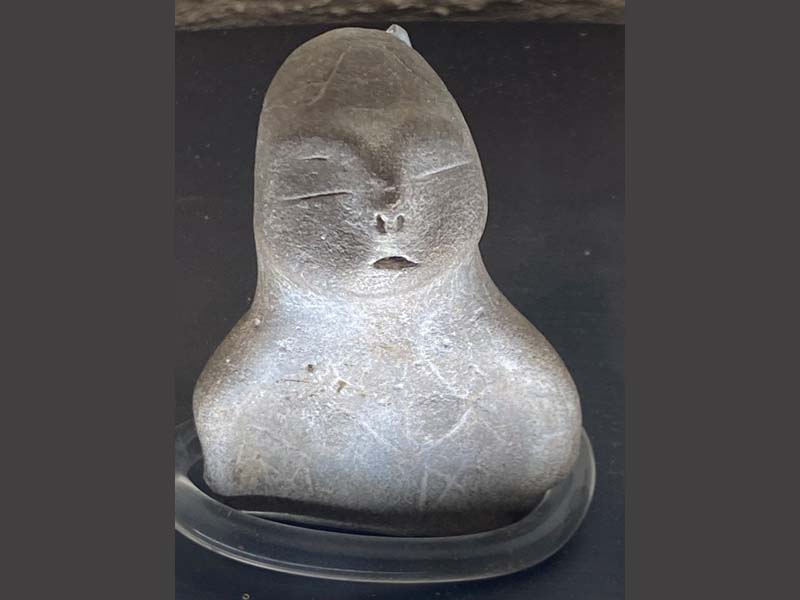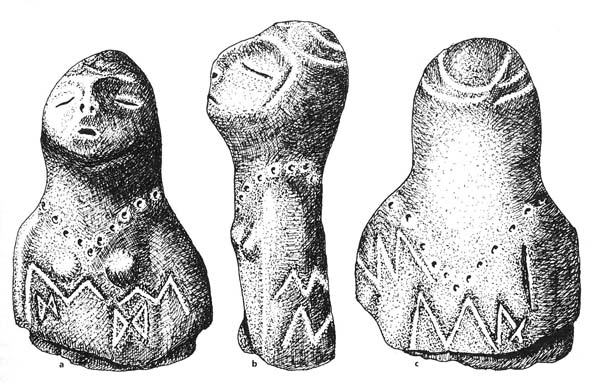di Maria Laura Leone
The well-known statue of Raven Pass it was found in the homonymous Neolithic village in the plain of Foggia, at the foot of the Gargano mountains. She has been photographed and analyzed several times, commented on in various writings[1]; and portrayed in a relief that well highlights her symbols, described in the complete work of Maria Gimbutas[2]. But the present photo (fig. 1) could reveal an identity never described.
It is kept 27 km from its place of origin, in the Castle Museum of Manfredonia, in a small illuminated case that resembles a cave, together with contemporary figurines: one of his village companions and three "cousins" from other sites; that of S. Matteo Chiantinelle (Serracapriola) and of Canes of the Battle (Barletta). But she is special and this light highlights details that could betray the reason for her existence, the thoughts that prompted her execution. And I have no qualms about imagining it made by a woman.
Seen in this splendid photo, it seems to reveal a touching truth that has perhaps always been before our eyes. A truth enclosed in an essential, clear form, conceived in a small bust marked by barely visible zig-zags and hourglasses.
Looking at her in this photo, it appears to me as never seen and if previously, like others, I saw her immersed in a trance, with eyes closed in ecstasy, in the wake of other statuettes portrayed in deep meditation or hieratic prayer[3], now my thoughts turn to an infant. A little girl who doesn't sleep but dies and whose soul is about to travel backwards the way to the other world.
The symbols that accompany it are those of the Goddess, signs, footprints, tatoos that try to give her life back. Once she was covered in ochre[4], the substance that gave life to those who no longer had life[5]. Symbols yet to be fully understood but which can be framed in the sphere of fundamental elements: the hourglass similar to the female body that it generates and the zig-zag similar to the waves of a liquid. Liquids are mother's milk, uterine humours, water that quenches thirst. In this regard, the W-shaped signs should also be mentioned, painted on a plastic female face (fig. 2) found in Cave of the Deers (Port Badisco, Otranto).
In the zigzag there is also an analogy with the constellation Cassiopeia[6].
The shape of Cassiopeia is interesting, from the sky it speaks to us through a zig-zag, which in autumn has the shape of M and in spring it has the shape of W, both letters similar to the acronym of Mamma, Maia, Mater, Madre, Maria, and letter still indicating the Virgin (fig. 3). It is not excluded that the statuette in question, like the other similar ones, rotated in the sphere of shamanic actions performed by women. Many must have thought of an infant, discarding an obvious identity.

We archaeologists, studying, analyzing and numbering, do not always allow ourselves the mental space to penetrate the daily life of the lives that took place in a newly excavated hut or in the tears that melted around a deposition. In fact, a drama that has been repeating itself for millennia after birth is not taken for granted. The pain of a mother who implements every procedure in order not to forget her own creature, entrusting it to heavenly care, is not trivial. Why, couldn't this figurine be a real girl? She covered by the sacred signs of the celestial parent and wearing her bonnet, her necklace. Why not think of a dying infant to be entrusted to Her power? Or, and it shouldn't even be excluded, that it was her: the Great Mother child who, even before the Christian Redeemer, was born on a cold winter night. This seems to be this absolute unicum of eight/seven thousand years ago. A gesture of love shaped in the light of a hearth, perhaps accompanied by a mother who sings a dirge in which she prays the Goddess to heal the little one, keep her warm and protect her when the cold north wind descends from the Gargano mountains and brings frost to the village .
The faces of the statuettes seem to speak to us and their closed eyes could refer to a deep meditative state, as to prayer, dreams or death. They are already idealizations and must be seen in real life, photographed under the best lights and from different angles. Archeology will not be an exact science, but neither will it be inexact and there is still much to explore about the "feeling of the Goddess".
Footnotes
[1] Santo Tine – Passo di Corvo and the Neolithic civilization of the Tavoliere – Genoa – Sagep 1983 – p. 201;
Maria Antonietta Fugazzola Delpino and Vincenzo Tiné – “The clay female figurines of the Italian Neolithic. Iconography and cultural context” – in Bulletin of Italian Palethnology – Volume 93-94 – New Series XI-XII – Rome – State Mint Polygraphic Institute – 2002-2003;
[2] Marija Gimbutas – The language of the Goddess. Myth and cult of the Mother Goddess in Neolithic Europe – Milan – Longanesi – 1990 – p. 390;
[3] Maria Laura Leone The phosphenic Grotta dei Cervi. Art, mythology and religion of the painters of Porto Badisco – Espresso www.miolibro.it – Rome 2009;
[4] Santo Tine – Passo di Corvo and the Neolithic civilization of the Tavoliere – Genoa – Sagep 1983 – p. 201;
[5] Maria Laura Leone - "Philosophy of the afterlife in the Apulian Paleolithic" - in Hypogea, notebooks of the IISS “S. Staffa” of Trinitapoli – December 2006 – n.1 – pp. 83-92;
[6] Enrico Calzolari – The prehistory of Caprione. Ethnoscience and palaeoastronomy research carried out on the promontory overlooking the Gulf of Poets – Marne – Lecco 2006.
Maria Laura Leone, 8 January 2023




